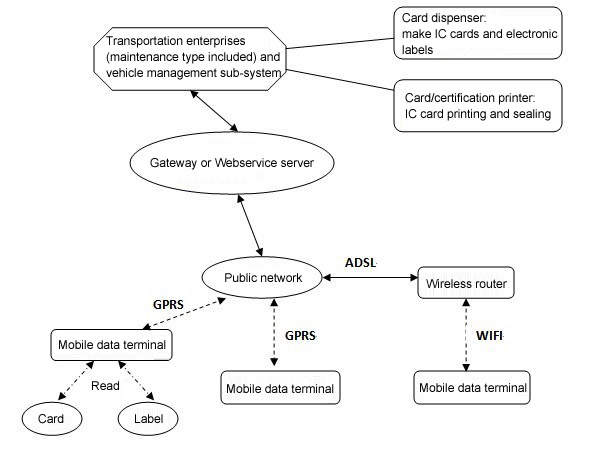Summary
1.Background
Experimental spots of establishing maintenance enterprise management information infrastructure includes 3 sub-systems: maintenance enterprises and vehicle management, video monitoring and mobile data terminal sub-systems. Through data transfer and business transaction levels, the 3 sub-systems are able to realize optimized and regulated monitoring and management on vehicle repair.
This document is to give details about solution building of handheld data terminal sub-systems. It also mentions the shared technologies and standards in other 2 subsystems since they are related to each other as to business transaction and data transfer.
2.References
1) E-government platform cataloging and encoding rules for road transportation;
2) E-government platform data transfer formats for road transportation;
3) Information and standards of e-government platform for road transportation;
Design targets and rules
1.Design targets
They system design target is through building 3 sub-systems:
1) establish and realize electronic ID of vehicles;
2) scientific and informative management on vehicle repairing and maintenance;
3) monitoring and inspection to maintenance enterprise and repair procedures. These will help minimize traffic accidents and ensure smooth vehicle repairing and transportation safety.
2.Design rules
1) Standardization
The design of overall system has uniformed data collection rules and quality standard, it also need to strictly follow national and regional relations and industry standards.
2) Advancement
The overall design of the system has brought the good experience from various systems and introduces system building experience of the same kind. Technically, it adopts sophisticated international technology and ensures design is carried out based on software engineering standards. As a result, it's more advanced.
3) Safety
System should be able to provide a complete safety system. It has to solve problematic issues such as external illegal inquiry system; internal legal user inquiry without permission; access system with embedded SQL; accidental damage to data; inappropriate operation by users etc.
4) Extendable
In system development the infrastructure should be modularized, software platform can be modular assembled so as to ensure long lifespan and expandability for upgrading requirements.
5) Stability
Stability refers to system accuracy and robustness. Before submission they system carries out various standard tests, so as to minimize errors and ensure normal operation of the system. On the other hand, the system should have good robustness, with good error accommodation capability, and be able to give correct indications when accidents occur. These will help to ensure safe recovery of data.
6) Openness
The system should be open for information and configuration approach. This ensures that the upfront investment is effective and the system can develop periodically to achieve completeness. And it shall be easy for upgrading and extension, and be able to adjust the changes of related regulations in the future.
Building contents

Instructions:
1) Maintenance enterprises and vehicle management sub-systems are added with card dispensing function, which writes vehicle information into IC cards and electronic labels.
2) Maintenance enterprises and vehicle management sub-systems are added with certification/card printing function, which prints vehicle information on the card and seals via a printer.
3) SOCKET gateway or WEBSERVICE application should be established on the server of sub-system.
4) Programming on handheld data terminals, read IC card and electronic labels and transfer data to SOCKET or WEBSERVICE via GPRS or WiFi. Operation is carried out via service programs.
